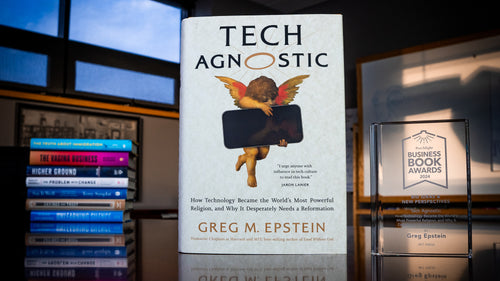An Excerpt from The Power of Instinct
 People don’t make decisions with their conscious mind, but on instinct. In The Power of Instinct, marketing consultant and behavioral science expert Leslie Zane shows that to grow a brand, business, or even a social movement, traditional persuasion tactics fall short. Instead, you must connect to the instinctive mind. And to do this, you need to understand the science of consumer choice and employ techniques that work with a person’s brain, not against it.
People don’t make decisions with their conscious mind, but on instinct. In The Power of Instinct, marketing consultant and behavioral science expert Leslie Zane shows that to grow a brand, business, or even a social movement, traditional persuasion tactics fall short. Instead, you must connect to the instinctive mind. And to do this, you need to understand the science of consumer choice and employ techniques that work with a person’s brain, not against it.
Zane uncovers the hidden network of connections that dictates the snap decisions we make and cracks the code on how to influence it. With a revolutionary set of rules for expanding the network, Zane shows us how to make any brand, business, political candidate, or idea the dominant instinctive choice.
Whether you're an entrepreneur, Fortune 500 executive, marketing professional, or job seeker, mastering the power of instinct will help supercharge your growth and make whatever you’re selling the first choice for any audience.
The following excerpt is the opening of Chapter 3.
◊◊◊◊◊
THE SHORTCUT TO INSTINCTIVE CHOICE
Instinct Rule: You can’t force people to buy your brand, but you can change their instinctive behavior.
An entire product line of cheese—in all types, shapes, and sizes—and you would be hard pressed to find a single cow on any of them.
In the mid-’90s, a major cheese company seemed to be operating on an unstated principle: we will avoid cows, dairy farms, and barns on all packaging and advertising. Instead of focusing on where their cheese came from, they marketed convenience with a major push into pre-shredded cheese, and a series of product innovations that took the market by storm. Shredded cheese made mealtime, and even snack time, easier, simpler, and of course, faster for busy parents across America. Who has the time to get out the grater and shred a block of cheese when the kids are clamoring for nachos?
The company bagged up shredded cheese in all manner of customized variations—mozzarella for pizza night, a signature cheese blend for tacos, pepper jack for a kick to your eggs in the morning—and sold millions of units. But by focusing virtually all their advertising and promotional efforts on these precut shreds and resealable plastic bags, new unintended associations slowly accumulated in consumers’ minds, unbeknownst to the heads of the company. Over time, these associations turned into implicit barriers: this pre-shredded, pre-bagged product was not real cheese at all, but some highly processed, unnatural, plastic-filled concoction. The brand had been losing market share ever since.
Maybe they refused to place cows on their packaging because they associated them with the smell of manure, or dirtiness, or even global warming (cows are, after all, the number-one agricultural source of greenhouse gas emissions into our atmosphere). Or maybe they felt the company needed to stay away from what they considered generic dairy iconography. Unfortunately, the decision by one of the largest cheese companies in the world to not use “source imagery”—visuals of where your food originates—left a giant opening.
Meanwhile, almost every private and store label manufacturer—from Aldi (Happy Farms) and Safeway (Lucerne Dairy Farms) to Kroger—came out with their own cheese brands, placing red-and-white dairy barns, silver silos, and Holstein cows all over their packaging. These brands managed to take a significant chunk of market share away from the long-standing company. Though consumers originally felt the brand’s product was superior to the store label varieties, and were willing to pay the price differential, they started believing these store-brand cheeses were just as good, maybe even better. Still, no cows.
Ask consumers what images of cheese they find most appealing—which ones they like best—and they will point to the stretchy topping on a piece of pizza, gooey slices bursting out the sides of a burger, or a forkful of melted deliciousness in the perfect bite of lasagna. But ask the same consumers what superior cheese looks like and the images stored in their minds are completely different. Visuals of cheese wheels and wedges universally come to mind, along with cows, dairy farms, and grassy fields under bright blue skies. Even the locations are the same—rural Wisconsin, pastoral Vermont, and other places close to the source of cheese, all of which they equate with high quality.
With no mandate restricting them, private label brands jumped into source imagery with both feet. As positive associations of dairies, cows, and real cheese were added to the Brand Connectome of store-brand cheeses, a myriad of neural pathways sprouted. Little by little, store and private-label cheese connectomes became physically larger—as quality and expertise associations increased, their salience in the mind grew. Private-label cheese became consumers’ instinctive go‑to choice, while the company’s connectome became laden with negative associations and less salient. It’s hard to believe this could happen. The company was one of the first to sell cheese to the masses in the US; its dairy expertise is irrefutable. But when it comes to the unconscious mind, reality doesn’t matter—it’s all about perception and the resulting associations.
Consumers don’t need advertising to tell them what these images mean, or that a particular brand of cheese is more wholesome, natural, and authentic. American culture has already done that work for them. The associations have been ingrained in our memories over our lifetimes. By associating itself with dairy farms and cheese wheels and wedges—which feel authentic and close to the source of real dairy, placing them on a pedestal in our minds—a brand, whether well established or new to the market, can piggyback on those connections. These are not fleeting emotions. Rather, the brand is tapping into implicit associations already written into our neural pathways. This is the path of least resistance—piggybacking on what is already in the mind. Importantly, the emotional connection we feel with a brand or product is an outcome of all these positive associations, not an input.
Since the mid-2000s, psychologists such as Daniel Kahneman have opened our eyes to the irrational nature of decision-making. In Kahneman’s case, Thinking, Fast and Slow went mainstream, providing the public with a new understanding of behavioral science. The entire marketing and advertising industry jumped on the bandwagon, but they jumped to the wrong conclusion. Since people make decisions irrationally, they reasoned, we need to communicate emotionally to them.
But emotional connection doesn’t work that way, and this concept has remained one of the most persistently misunderstood aspects of marketing. There is no such thing as brand love. A bond is not created by overtly expressing an emotion, and it has nothing to do with messages that are humorous, wistful, or sentimental, no matter how clever. Emotions are fleeting—laugh at something and then the feeling is gone—they don’t seep into people’s memory structure. Instead, you have to tap into existing associations that people already hold in their minds and connect them with your brand—that’s what creates emotional connection.
The company did ultimately start using imagery of wedges and wheels of cheese and prominently featuring the words “Natural Cheese” across their packaging. Though this approach helped pull back in some customers that had been lost to the private labels, the company’s market share never quite returned to their highest levels. What they should have done throughout their transition to emphasizing “convenience” was incorporate the dairy farm and superior cheese imagery as well. For example, they might have depicted a master cheese maker carving a piece of cheese off the wheel, showing where those shreds of cheese actually came from. If these images and ideas had been presented together, they would have communicated “natural” and “convenient” simultaneously, an effective layering of multiple messages that could have expanded salience.
Excerpted from The Power of Instinct: The New Rules of Persuasion in Business and Life, reprinted here with permission of the publisher, PublicAffairs.
Copyright © 2024 by Leslie Zane.
All rights reserved.



